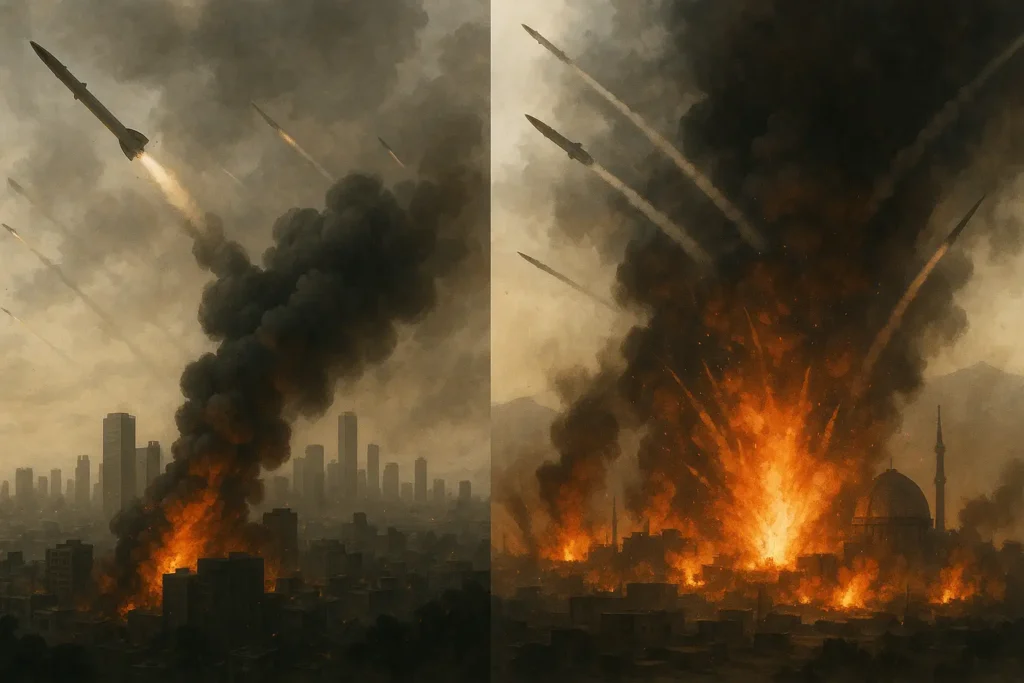The Iran–Israel conflict intensified again, with missile strikes hitting major urban centres on both sides. Here’s a clear and human‑centered breakdown of what’s happening on the ground.
Cities in Israel That Were Hit
Haifa
- Development: Iran targeted Haifa’s Bazan oil refinery—causing fires and widespread disruption. Residential neighbourhoods in Neve Sha’anan also took direct hits, wounding around 23 people .
Beersheba
- Impact: Southern Israel felt the brunt too. A missile struck near the Soroka Medical Center, causing structural damage and injuring dozens (reports vary between 7 to over 70) . A separate strike near high-rise buildings filled the skies with thick black smoke—but there were no fatalities .
Tel Aviv & Surroundings
- Sirens warned residents as Iranian missiles flew overhead. Some residential and government buildings sustained damage, though detailed casualty figures remain unclear .
Other Areas: Rishon LeZion, Bat Yam, Rehovot, Tamra
- Events: Earlier waves of missiles hit these locations on June 15–16, causing civilian casualties, destruction of homes, schools, and scientific centres like the Weizmann Institute .
Iranian Cities and Facilities Struck by Israel
Tehran & Nearby Military Sites
- Details: Israel launched airstrikes targeting missile bases, including Iran’s ballistic missile air-defence site, Mehrabad Airbase, and other storage or command facilities .
Kermanshah & Tabriz
- Strikes: Israel destroyed underground missile facilities and launch sites in both provinces using airpower, inflicting significant damage on Iran’s military infrastructure .
Additional Targets: Arak, Natanz, Bushehr
- Context: Israel also hit Iran’s nuclear-related facilities like Arak heavy-water reactor, Natanz site, and Fajr-e Jam gas refinery during this escalation .
Why These Cities Were Targeted
- Iran’s Aim: Retaliate for Israeli strikes by targeting major Israeli cities and critical facilities.
- Israel’s Objective: Cripple Iran’s missile-launch capabilities and nuclear ambitions by targeting military and strategic infrastructure. Both governments frame this as vital for national defense—but civilians are bearing the brunt.
Human Toll & Next Steps
- Israel reports dozens of wounded and around 24 fatalities in recent weeks, impacting hospitals, homes, and community life.
- Iran says over 639 people have been killed and 1,300+ injured by Israeli retaliatory strikes .
- Global Response: Diplomatic pressure from Europe, talk of U.S. military involvement, and regional warnings suggest further escalation—but also international calls for ceasefire.
What to Watch
- 🔹 Escalation vs Diplomacy: Will Iran and Israel continue airstrikes or pause for negotiations?
- 🔹 U.S. Position: President Trump is weighing military options—watch for statements in the next 1–2 weeks.
- 🔹 Humanitarian Impact: Hospitals and civilians caught in the crossfire highlight the critical need for protection and aid.
Summary
Iran’s latest rocket salvos struck Haifa, Beersheba, and ports of Tel Aviv, while Israel responded with precision airstrikes on facilities in Tehran, Kermanshah, and Tabriz. Civilian injuries and infrastructure damage are mounting, with the intense military exchange overshadowing diplomatic efforts—yet the world still watches for a negotiated pause.

